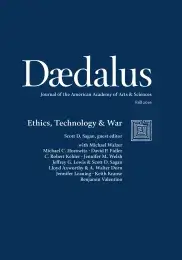Nuclear Weapons & Nuclear Use
While nuclear weapons were conceived to end a war, in the aftermath of their operational use at Hiroshima and Nagasaki, they became the central (and controversial) means to prevent a war. Nuclear deterrence formed the foundation of U.S. Cold War doctrine and the basis of an extended security guarantee to our allies. But the Cold War ended one-quarter century ago, and questions about the efficacy of deterrence, the need for nuclear weapons, and the ethics surrounding them have resurfaced as some call for further major reductions in inventory or the complete elimination of the U.S. nuclear arsenal. Discussed from the perspective of a military practitioner, this essay highlights the continuing need for U.S. nuclear weapons in a global security environment that is highly complex and uncertain, and describes the means by which the credibility of the nuclear portion of the strategic deterrent is being preserved even as the role and prominence of these weapons have been reduced.
Among the many responsibilities I had as the Commander of United States Strategic Command (USSTRATCOM), none was greater than my responsibility to plan, operate, and, if ordered by the president, employ the nation’s long-range nuclear forces in combat. Beginning with General George C. Kenney in 1946, a long line of senior officers has held that responsibility in what is arguably one of the most consequential military posts in the world. While USSTRATCOM’s responsibilities have grown since 1992 – when it assumed the combatant command and planning roles of its predecessors, Strategic Air Command (SAC) and the Joint Strategic Target Planning Staff (JSTPS) – every commander since Kenney has shared a common critical mission: to deter attack (primarily nuclear attack) against the United States and its allies and partners, and to use nuclear weapons to defend the nation if deterrence fails.
But the twenty-first-century international security environment is far different from the bipolar Cold War contest that originally defined this mission. The massive conventional threat posed by the Soviet Union and Warsaw Pact disappeared almost twenty-five years ago. While it is still possible (and still must be deterred), the likelihood of a large-scale surprise nuclear attack has declined. The traditional regional battlefield is becoming a global battlespace as adversaries acquire technologies and exploit the interconnected nature of our world to quickly transit political, geographic, and physical boundaries. Attacks by violent extremists and the possibility of nuclear terrorism are immediate security concerns; cyber weapons and drones present new challenges; and traditional weapons like ballistic missiles and advanced conventional capabilities are more available, affordable, and lethal. USSTRATCOM and its sister Combatant Commands (CCMDS) may be called on to face diverse contingencies that unfold suddenly and range from small arms in the hands of violent extremists to nuclear weapons in the hands of hostile state leaders. . . .
